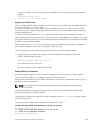
Virtual Links
In the case in which an area cannot be directly connected to Area 0, you must configure a virtual link
between that area and Area 0.
The two endpoints of a virtual link are ABRs, and you must configure the virtual link in both routers. The
common non-backbone area to which the two routers belong is called a transit area. A virtual link
specifies the transit area and the router ID of the other virtual endpoint (the other ABR).
NOTE: You cannot configure a virtual link through a stub area or NSSA.
Router Priority and Cost
Router priority and cost is the method the system uses to “rate” the routers.
For example, if not assigned, the system selects the router with the highest priority as the DR. The second
highest priority is the BDR.
• Priority is a numbered rating 0 to 255. The higher the number, the higher the priority.
• Cost is a numbered rating 1 to 65535. The higher the number, the greater the cost. The cost assigned
reflects the cost should the router fail. When a router fails and the cost is assessed, a new priority
number results.
Figure 94. Priority and Cost Examples
626
Open Shortest Path First (OSPFv2 and OSPFv3)


















